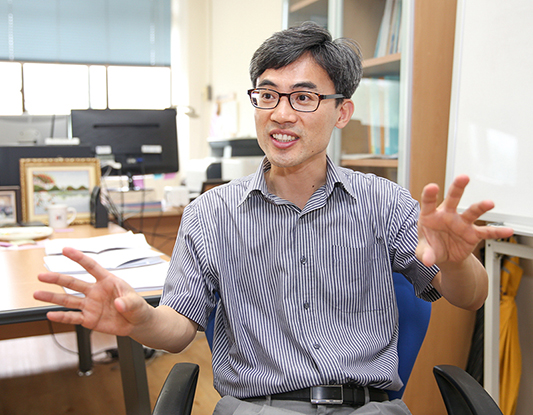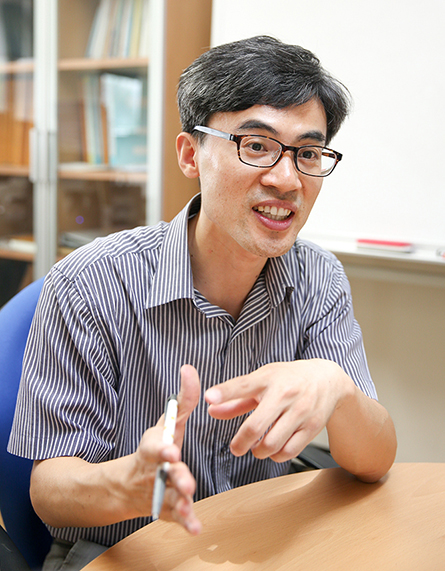Next Generation Solar Cell, Prof. An Gwangsun Makes its Time of Commercialization Earlier N
No.88782- Writer pr
- Date : 2015.06.24 11:13
- Views : 7866
New Efficient Technology of Quantum Dot-Sensitized Solar Cell(QDSSC) as Highlighted Future Energy Source
High Performance, High-Durability and Low Price Catalyst Evidently Increases Solar Cell Performance
Published on the newest issue of <Scientific Reports>, one of world-top journals
[2015-6-8]
High Performance, High-Durability and Low Price Catalyst Evidently Increases Solar Cell Performance
Published on the newest issue of <Scientific Reports>, one of world-top journals
[2015-6-8]

<Prof. An of chemical engineering department explains his research result.>
Professor An(40)’s chemical engineering team developed a new efficient technology of energy generation in low price using Quantum Dot-Sensitized Solar Cell (‘GDSSC’), where quantum dot is an nano-semiconductor particle absorbing easily the light.
Prof. An’s team has jointly collaborated with Prof. Seong Youngeun(51)’s team in Seoul National University and Dr. Go Minjae (44)’s team in KIST for this research. This research has a scientific significance in that solar energy could be used more efficiently.
The QDSSC is one of solar cells which have been actively studied to use as a next generation energy source since it was firstly reported in 1998. In order to increase the efficiency of QDSSC, it needs a technology enabling to absorb the sun light efficiently and generate much more electrons. There was one of technological difficulties how quickly the electron arrived at the catalyst electrode is to reduce the electrolyte. Notwithstanding its importance, there has been little progress in the research of alternative catalyst electrode.
Instead of the previously used catalysts of platinum, gold and copper sulfide, the research team developed newly nickel nitride catalyst electrode which shows high durability, higer performance and low price, and successfully increased the performance of QDSSC. The research team has paid a special attention to that nitride-based chemical compound shows very excellent durability, and synthesized a nickel-based nitride (the so-called nickel nitride) showing a catalytic characteristic. This research finally proved that the nickel nitride catalyst has much more excellent performance and durability than the previous catalysts.

Professor An, as the correspondence author in this research, mentions hopefully, “The supply of renewable energy including solar cell area is still very low over the world. In order to use the sun as a sustainable source of energy, what is more important is the technology with price competitiveness. We hopefully expect this research will make earlier the commercialization of QDSSC.”
This research result was published on the newest (May 21) online version of <Scientific Reports> with the title of “Development of Alternative Catalyst Electrode for Quantum Dot-Sensitized Solar Cell using Nickel Nitride.” Scientific Reports is an integrated world-class science journal covering the whole scientific areas of physics, chemistry and biology, and hits the top 7.3% in the similar science fields with a high impact factor of 5.078. It has been issued by the Nature Publishing Group, famous for the weekly science journal Nature.
Professor An expresses his wishes, “I specialize in the research areas of development of photoelectrochemical energy material using nano-structured substances, development of new generation solar cell material, photoelcectrochemical water-dissociated cell for hydrogen generation, development of electrochemical catalyst. I will continue the convergence research in my field jointly with Seoul National University and KIST. They posses the world-level research capacity.”
This research was funded by Core Laboratory Support Project by the Ministry of Education and BK21 Plus Project of the National Research Foundation of Korea